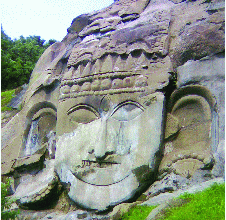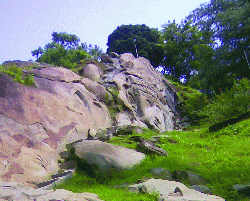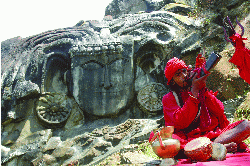Unakoti
Unakoti India’s Largest Bas-relief Sculpture
 The Encyclopedia Britannica defines relief sculpture as “Relief sculpture is a complex art form that combines many features of the two-dimensional pictorial arts and the three-dimensional sculptural arts. On the one hand, a relief, like a picture, is dependant on a supporting surface, and its composition must be extended in a plane in order to be visible.
The Encyclopedia Britannica defines relief sculpture as “Relief sculpture is a complex art form that combines many features of the two-dimensional pictorial arts and the three-dimensional sculptural arts. On the one hand, a relief, like a picture, is dependant on a supporting surface, and its composition must be extended in a plane in order to be visible.
On the other hand its three-dimensional properties are not merely represented…”Bas-relief (pronounced bah-re-lief or bas-re-lief) is a method of sculpting which entails carving or etching away the surface of a flat piece of stone or metal. The word bas-relief is derived from the Italian basso rilievo meaning “low contrast”, as opposed to alto rilievo or “high contrast”.
Bas relief has existed in all civilizations from ancient Egypt, Mesopotamia, India, and China, through the classical, middle ages, and on through the renaissance. Here I am going to narrate about one such bas-relief sculpture in a remote part of India, Tripura.
Considered to be the biggest bas-relief sculpture in India, Unakoti i.e. one less than a crore (10 million) in Tripura dates back to the 7th - 9th century AD. However, according to the Archaeological Survey of India (ASI), Unakoti dates back to the 8th or 9th century. Given the significance of its heritage status, there is a talk of UNESCO declaring it a world heritage site.
The Myths behind the Unakoti bass-relief
According to Hindu mythology, Lord Shiva was on a journey towards Kashi along with a crore of gods and goddesses. Being tired he decided to make a night halt at this place (Unakoti). At night He (Shiva) had asked all the gods and goddesses to wake up before sunrise and prepare themselves to resume the long journey. However, to His dismay nobody got up except for Himself. So He set out for Kashi by Himself cursing the others to become stone images. It is this curse that made them all stone images except Lord Shiva himself. As a result there is one less than a crore stone image carvings at Unakoti.
The other myth says that one sculptor wanted to make Unakoti a place of pilgrimage for a crore of deities. But unfortunately his dream was not fulfilled as he could not complete it, running short by just one image. This is why this place came to be known as Unakoti.
The Divine Sculptures
 All the images found at Unokoti are of two types namely rock-carved figures and stone images. Central to these rock cut carvings are the master pieces, Shiva and Ganesha. The Shiva head is carved in a vertical rock face. This colossal image curved in grey stone is commonly known as ‘Unakotiswara Kal Bhairava’. It is about 30 feet high. Its head is embroidered in tresses forming a headdress of 10 feet high. On one side of this headdress there is the image of goddess Durga standing on a lion, while on the other there is another believed to be that of goddess Ganga sitting on a Capricorn. There are also images of Nandi Bull lying half buried in the ground. Near the central Shiva there is a small stream flowing from between the rocks.
All the images found at Unokoti are of two types namely rock-carved figures and stone images. Central to these rock cut carvings are the master pieces, Shiva and Ganesha. The Shiva head is carved in a vertical rock face. This colossal image curved in grey stone is commonly known as ‘Unakotiswara Kal Bhairava’. It is about 30 feet high. Its head is embroidered in tresses forming a headdress of 10 feet high. On one side of this headdress there is the image of goddess Durga standing on a lion, while on the other there is another believed to be that of goddess Ganga sitting on a Capricorn. There are also images of Nandi Bull lying half buried in the ground. Near the central Shiva there is a small stream flowing from between the rocks.
About fifty meters downstream from the huge Shiva image, there are three magnificent images of Lord Ganesha. There is also a huge figure of the four-armed seated Ganesha and on its side two standing figures of Sarabhuja Ganesha with three tusks and the Asthabhuja Ganesha with four tusks- a rare sight to behold.
Another three-eyed figure a little far away is believed to be that of Surya or Lord Vishnu. Besides the huge Ganesh figure, there is also a chaturmukha Shivlinga nearby. Among other rock-cut and stone images are those of Vishnu, Nandi, Narasimha, Shri Ram, Ravana, Hanuman, and several unidentified deities. All these date back to the ancient Buddhist and Hindu periods. There are also murals i.e. wall paintings, frescos, friezes with their primitive beauty half preserved. It is said that there are unakoti (one less than a crore) rock cut carvings available here but all of them are yet to be discovered.
It is enchanting to take a dip inthe little waterfall near the Ganesha images, about fifty meters downstream from the central Shiva, as mentioned earlier. The water is slightly dull in colour, which is a common feature for every water body—either rolling or still in this tropical landscape. The force and noise with which the waterfall hits you is very pleasing. It is as if you forget the dark reality of this pestilence stricken world at least for that moment! As we climb up the stairs towards the hill top, we come across a number of rock carvings which are still to be identified. Amidst this spectacular scenic beauty, the huge banyan trees there dry away all our tiredness and we are as if re-energised to begin our lives afresh.
On visiting the place, the impression that one draws is that there is the predominant impact of the Shiva cult. The archeologists also share a similar belief. However, the influences of several other cults like Tantric, Shakti, and Hatha yogis are also found to be present. Sometimes it is assumed that the site dates back to the period between the 12th and 16th centuries AD, and that the sculptures belong to two different periods of art.
We can find an exquisite blend of myth, religion and nature at Unakoti. Of the two myths suggested earlier, the former is the predominant one. However, religion is the most important reason why people travel from far off places to have a glimpse of the deities. Every year, a big fair popularly known as ‘Ashokastami Mela’ is held during April in which thousands of devotees visit this place to offer their prayers. This entire fair happens amidst the natural surroundings, giving a perfect impression of a unique harmony between man and nature.
 The journey
The journey
The site is situated in Unakoti in the town of Kailasahar which is about 108 kilometers (by train) away from the capital. It is a 3 hour and 15 minutes journey away from the town. Travelling by road, it is 178 kilometers away. The train will drop you at Kailasahar from where you need to take a shared auto. It will take you to the town in 45 minutes for Rs. 25.00. From there you can hire an auto for Rs. 200.00 to get to the spot. The entire spot can be seen in a few hours. For lodging, the government circuit house or guest house in the town is the best. It costs only Rs 150.00 per head per night.
As habitually, a kind of nostalgia spread on me as I left this tourist place. Although there is also another reason behind this as my younger brother-in-law stays there, it nevertheless has cast a spell on me. Besides, I am also a ‘travel-maniac’. I can not claim to have visited as many places as far as the phrase goes, however, I have always had a yearning to see new places. There is a sort of an inner urge to move on and on, to go forward and to explore the unexplored. This is the impression I bore as I left the spot. And sharing these musings with you will perhaps help soothe me, as expressing one’s intense feelings with others always do.

